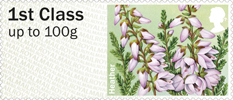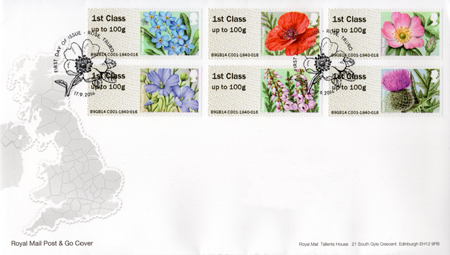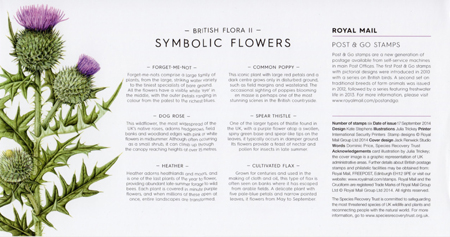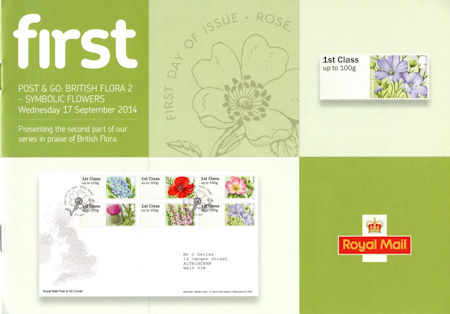Post & Go: Symbolic Flowers - British Flora 2
2014 (September 17 2014)Stamps
Forget-Me-Not
1stImage preview by Royal Mail
Forget-me-nots comprise a large family of plants, from the large, striking water variety to the tiniest specialists of bare ground. All the flowers have a visible white ‘eye’ in the middle, with the outer petals ranging in colour from the palest to the richest blues.
 Forget-Me-Not at Wikipedia
Forget-Me-Not at Wikipedia
Common Poppy
1stImage preview by Royal Mail
This iconic plant with large red petals and a dark centre only grows in disturbed ground, such as field margins and wasteland. The occasional sighting of poppies blooming en masse is perhaps one of the most stunning scenes in the British countryside.
 Common Poppy at Wikipedia
Common Poppy at Wikipedia
Dog Rose
1stImage preview by Royal Mail
This wildflower, the most widespread of the UK’s native roses, adorns hedgerows, field banks and woodland edges with pink or white flowers in mid-summer. Although often occurring as a small shrub, it can climb up through the canopy reaching heights of over 15 metres.
 Dog Rose at Wikipedia
Dog Rose at Wikipedia
Spear Thistle
1stImage preview by Royal Mail
One of the larger types of thistle found in the UK, with a purple flower atop a swollen, spiny green base and spear-like tips on the leaves, it typically occurs in damper ground. Its flowers provide a feast of nectar and pollen for insects in late summer.
 Spear Thistle at Wikipedia
Spear Thistle at Wikipedia
Heather
1stImage preview by Royal Mail
Heather adorns heathlands and moors, and is one of the last plants of the year to flower, providing abundant latesummer forage to wild bees. Each plant is covered in minute purple flowers, and when millions of these open at once, entire landscapes are transformed.
 Heather at Wikipedia
Heather at Wikipedia
Cultivated Flax
1stImage preview by Royal Mail
Grown for centuries and used in the making of cloth and oil, this type of flax is often seen on banks where it has escaped from arable fields. A delicate plant with five pale-blue petals and narrow pointed leaves, it flowers from May to September.
 Cultivated Flax at Wikipedia
Cultivated Flax at Wikipedia











